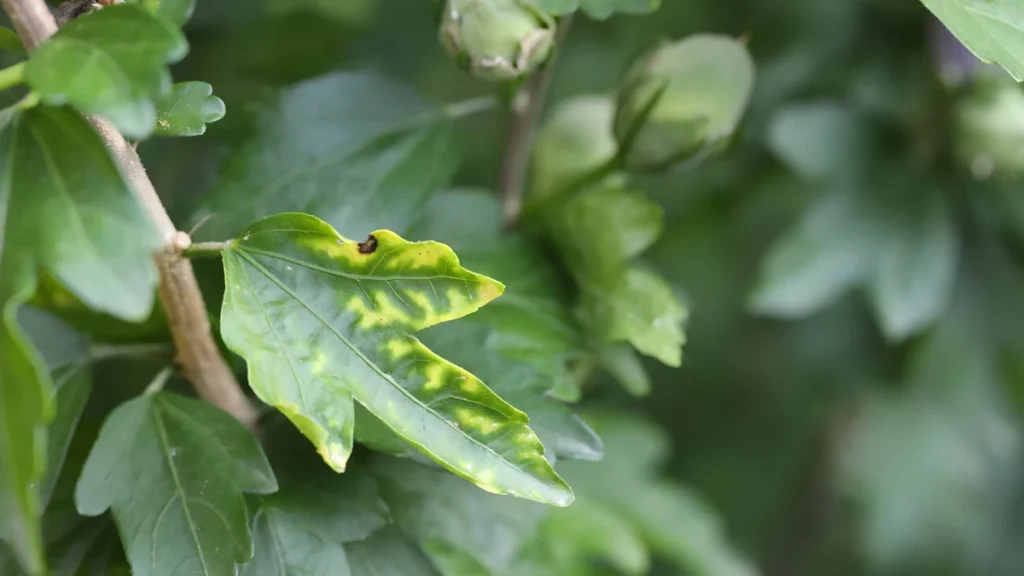Hibiscus plants are prone to several illnesses that may hinder their development and aesthetic appeal. Powdery mildew, bacterial blight, and root rot are three common hibiscus diseases. Symptoms of these illnesses frequently include wilting, yellowing leaves, slowed growth, and the appearance of black patches on the foliage. Inadequate maintenance, high moisture content, and inadequate air circulation can exacerbate these issues. Good management practices for hibiscus plants include routine inspection, upholding proper sanitation, and using the right remedies. Nonetheless, gardeners need to be vigilant about a few of the most prevalent hibiscus illnesses and their indications.
What is the hibiscus plant’s problem?
Even the healthiest types of hibiscus plants can exhibit rapid changes in appearance, which is a definite indicator of problems. Expert gardeners understand that to keep their gardens healthy, they must take preventative measures and identify infections early on. However, it’s not always as simple to identify hibiscus plant illness accurately as it looks. Both cultural norms and environmental variables are relevant. Environmental stresses including inadequate sunshine, improper watering techniques, or extremely high or low temperatures can weaken the plant and increase its susceptibility to these problems. To be healthy, a hibiscus plant requires proper maintenance, pest control, and supervision.
Find out how to treat hibiscus disease:
To cure hibiscus disease, it is necessary to first identify the underlying cause, which might be fungal infections, pests, or nutritional deficiencies. Prune afflicted areas and use fungicides as necessary to combat fungal diseases like leaf spots. Neem oil or insecticidal soap are effective ways to reduce aphids and spider mites. Additionally contributing to the prevention of illnesses are adequate air circulation, little wetness on leaves, and proper watering. Furthermore, early disease detection through routine inspection enables faster treatment and more robust plant development.
Some typical fungal hibiscus diseases are listed below:
1. Powdery Mildew:
Powdery mildew, like many garden plants, may proliferate in areas with favorable circumstances. Its spread is frequently aided by the onset of colder temperatures in the late summer. The first sign of this hibiscus disease, which gives leaves a powdery, white look, maybe spores on the leaf surface. This shows up on the hibiscus leaves, stems, and buds as a white, powdery residue. It may eventually cause the leaves to turn yellow and drop. This fungus is frequently encouraged by high humidity and inadequate air movement.
- Treatment: Eliminate the impacted leaves. Apply horticultural oil or fungicidal sprays. For optimal air circulation, make sure plants are spaced appropriately apart.
2. Phytophthora-like fungi that cause root rot:
This has an impact on the roots, causing wilting, yellowing, and growth retardation. It frequently occurs in soggy or poorly drained soil.
- Treatment: Reduce watering and enhance drainage. Apply fungicides to the soil. Don’t overwater.
3. Leaf Spot (caused by many fungus, including Cercospora):
Leaf spots are tiny, brown, or black dots on the leaves that have the potential to enlarge and ultimately cause the leaves to drop. The most distinctive feature of the leaf spot is its lesions, which are black patches with a lighter yellow halo surrounding them. This illness typically manifests itself in warm, humid weather.
- Treatment: Trim any impacted leaves. Use fungicides based on copper. Do not water the leaves directly; instead, moisten the root.
4. Botrytis Blight is caused by botrytis cinerea:
Known by another name, gray mold. This kind of hibiscus plant disease mostly affects flower buds, causing growth distortion and a grayish fuzz to cover each one. This disease causes gray mold to grow on stems, buds, or blooms, which rots the plant. It grows well in moist, chilly climates. Thankfully, the issue is rarely serious.
- Treatment: Take out the affected areas. Boost the flow of air. Apply fungicides if required.
Conclusion:
In conclusion, quick symptom detection, focused therapies, and good plant care are all necessary for the efficient treatment of hibiscus disease. Maintaining enough air circulation, avoiding excessive irrigation, and eliminating diseased leaves or stems are crucial in impeding the development of illness and promoting the health of hibiscus plants.
Certainly! If you’d like to learn more, please consider following our WhatsApp Channel: Harvest Gardening
A frequently asked questions:
Q1: How do you treat the hibiscus virus?
A1: Infected sections of Hibiscus plants, such as those infected with the Hibiscus chlorotic ringspot virus, should be removed and destroyed to stop the virus from spreading. Since there is no known treatment for viral infections in plants, maintain optimal plant health through appropriate soil drainage, watering, and pest management.
Q2: What are common diseases of hibiscus?
A2: Hibiscus leaf spot, which is brought on by fungus infections, and root rot, which is frequently brought on by overwatering or inadequate drainage, are common hibiscus illnesses. Both may cause plant deterioration and yellowing of the leaves.
Q3: What is the best fungicide for hibiscus?
A3: Copper- and neem-based fungicides are the best for hibiscus since they work well against fungal diseases like powdery mildew and black spots. Products such as Neem Oil and Bonide Copper Fungicide are frequently advised. Should the spots worry you, you may use a fungicide-containing Bayer Advanced 3-in-1 spray on the plants to prevent the fungal infection from spreading.

